engine coolant CHEVROLET KODIAK 2005 Owner's Manual
[x] Cancel search | Manufacturer: CHEVROLET, Model Year: 2005, Model line: KODIAK, Model: CHEVROLET KODIAK 2005Pages: 374, PDF Size: 5.46 MB
Page 255 of 374
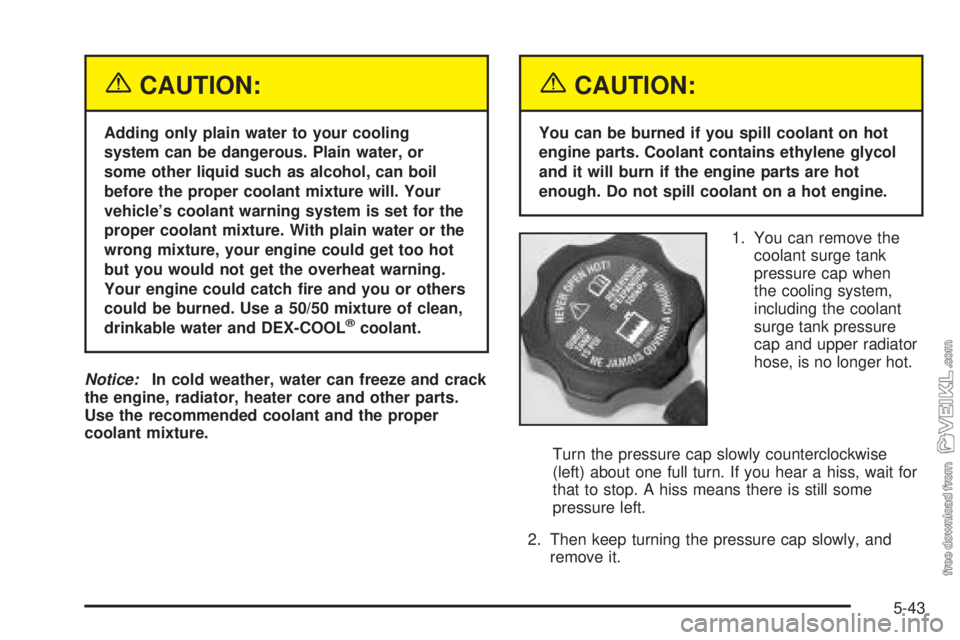
{CAUTION:
Adding only plain water to your cooling
system can be dangerous. Plain water, or
some other liquid such as alcohol, can boil
before the proper coolant mixture will. Your
vehicle’s coolant warning system is set for the
proper coolant mixture. With plain water or the
wrong mixture, your engine could get too hot
but you would not get the overheat warning.
Your engine could catch �re and you or others
could be burned. Use a 50/50 mixture of clean,
drinkable water and DEX-COOL
®coolant.
Notice:In cold weather, water can freeze and crack
the engine, radiator, heater core and other parts.
Use the recommended coolant and the proper
coolant mixture.
{CAUTION:
You can be burned if you spill coolant on hot
engine parts. Coolant contains ethylene glycol
and it will burn if the engine parts are hot
enough. Do not spill coolant on a hot engine.
1. You can remove the
coolant surge tank
pressure cap when
the cooling system,
including the coolant
surge tank pressure
cap and upper radiator
hose, is no longer hot.
Turn the pressure cap slowly counterclockwise
(left) about one full turn. If you hear a hiss, wait for
that to stop. A hiss means there is still some
pressure left.
2. Then keep turning the pressure cap slowly, and
remove it.
5-43
Page 256 of 374
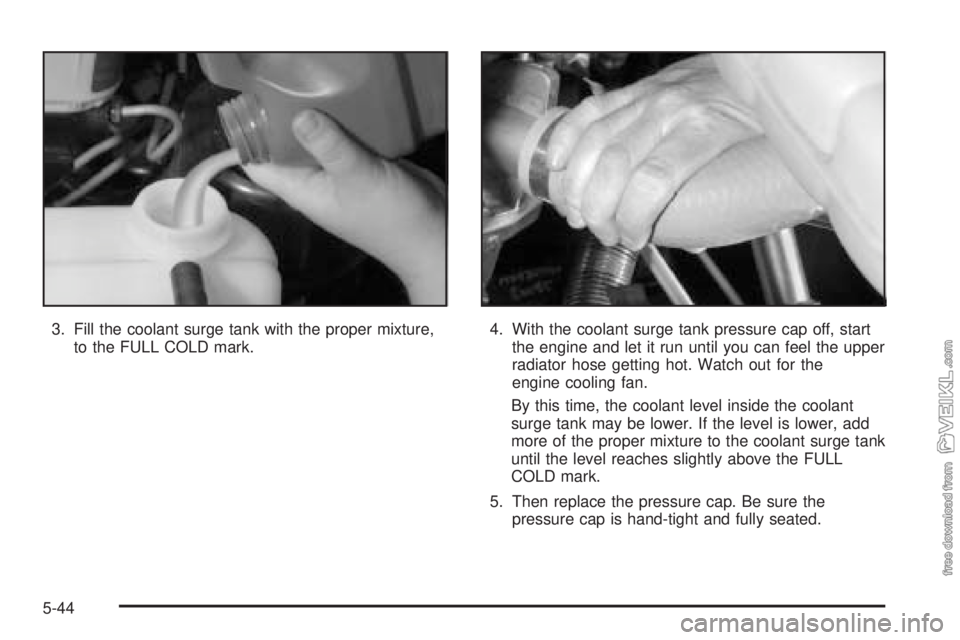
3. Fill the coolant surge tank with the proper mixture,
to the FULL COLD mark.4. With the coolant surge tank pressure cap off, start
the engine and let it run until you can feel the upper
radiator hose getting hot. Watch out for the
engine cooling fan.
By this time, the coolant level inside the coolant
surge tank may be lower. If the level is lower, add
more of the proper mixture to the coolant surge tank
until the level reaches slightly above the FULL
COLD mark.
5. Then replace the pressure cap. Be sure the
pressure cap is hand-tight and fully seated.
5-44
Page 258 of 374
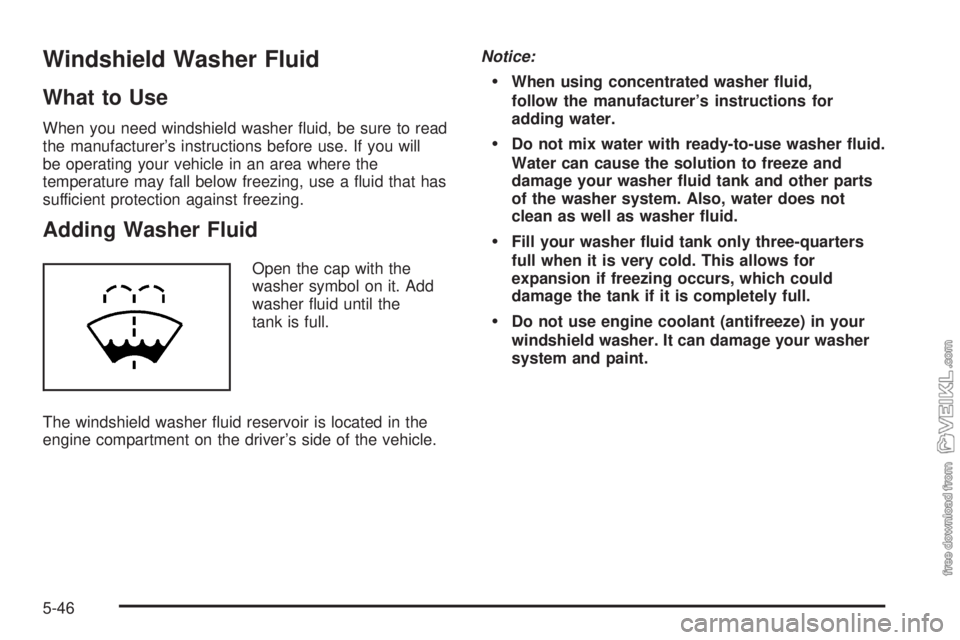
Windshield Washer Fluid
What to Use
When you need windshield washer fluid, be sure to read
the manufacturer’s instructions before use. If you will
be operating your vehicle in an area where the
temperature may fall below freezing, use a fluid that has
sufficient protection against freezing.
Adding Washer Fluid
Open the cap with the
washer symbol on it. Add
washer fluid until the
tank is full.
The windshield washer fluid reservoir is located in the
engine compartment on the driver’s side of the vehicle.Notice:
When using concentrated washer �uid,
follow the manufacturer’s instructions for
adding water.
Do not mix water with ready-to-use washer �uid.
Water can cause the solution to freeze and
damage your washer �uid tank and other parts
of the washer system. Also, water does not
clean as well as washer �uid.
Fill your washer �uid tank only three-quarters
full when it is very cold. This allows for
expansion if freezing occurs, which could
damage the tank if it is completely full.
Do not use engine coolant (antifreeze) in your
windshield washer. It can damage your washer
system and paint.
5-46
Page 339 of 374
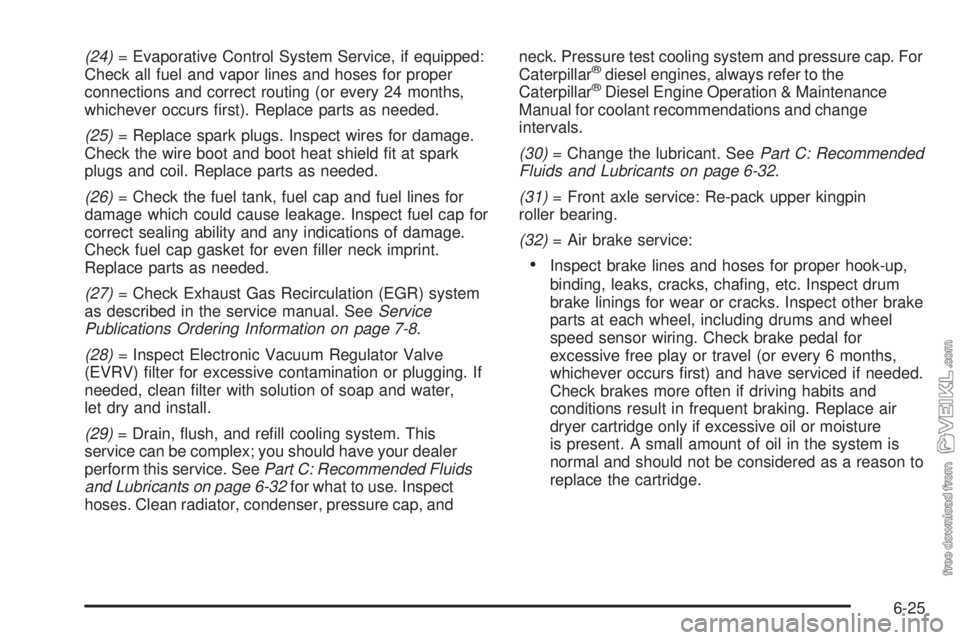
(24)= Evaporative Control System Service, if equipped:
Check all fuel and vapor lines and hoses for proper
connections and correct routing (or every 24 months,
whichever occurs first). Replace parts as needed.
(25)= Replace spark plugs. Inspect wires for damage.
Check the wire boot and boot heat shield fit at spark
plugs and coil. Replace parts as needed.
(26)= Check the fuel tank, fuel cap and fuel lines for
damage which could cause leakage. Inspect fuel cap for
correct sealing ability and any indications of damage.
Check fuel cap gasket for even filler neck imprint.
Replace parts as needed.
(27)= Check Exhaust Gas Recirculation (EGR) system
as described in the service manual. SeeService
Publications Ordering Information on page 7-8.
(28)= Inspect Electronic Vacuum Regulator Valve
(EVRV) filter for excessive contamination or plugging. If
needed, clean filter with solution of soap and water,
let dry and install.
(29)= Drain, flush, and refill cooling system. This
service can be complex; you should have your dealer
perform this service. SeePart C: Recommended Fluids
and Lubricants on page 6-32for what to use. Inspect
hoses. Clean radiator, condenser, pressure cap, andneck. Pressure test cooling system and pressure cap. For
Caterpillar®diesel engines, always refer to the
Caterpillar®Diesel Engine Operation & Maintenance
Manual for coolant recommendations and change
intervals.
(30)= Change the lubricant. SeePart C: Recommended
Fluids and Lubricants on page 6-32.
(31)= Front axle service: Re-pack upper kingpin
roller bearing.
(32)= Air brake service:
•Inspect brake lines and hoses for proper hook-up,
binding, leaks, cracks, chafing, etc. Inspect drum
brake linings for wear or cracks. Inspect other brake
parts at each wheel, including drums and wheel
speed sensor wiring. Check brake pedal for
excessive free play or travel (or every 6 months,
whichever occurs first) and have serviced if needed.
Check brakes more often if driving habits and
conditions result in frequent braking. Replace air
dryer cartridge only if excessive oil or moisture
is present. A small amount of oil in the system is
normal and should not be considered as a reason to
replace the cartridge.
6-25
Page 341 of 374
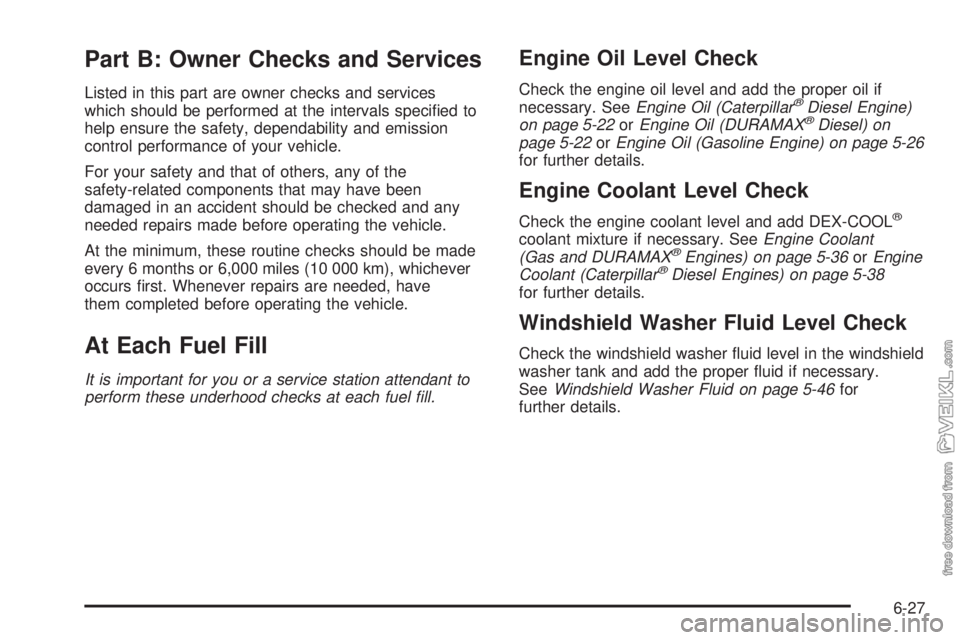
Part B: Owner Checks and Services
Listed in this part are owner checks and services
which should be performed at the intervals specified to
help ensure the safety, dependability and emission
control performance of your vehicle.
For your safety and that of others, any of the
safety-related components that may have been
damaged in an accident should be checked and any
needed repairs made before operating the vehicle.
At the minimum, these routine checks should be made
every 6 months or 6,000 miles (10 000 km), whichever
occurs first. Whenever repairs are needed, have
them completed before operating the vehicle.
At Each Fuel Fill
It is important for you or a service station attendant to
perform these underhood checks at each fuel �ll.
Engine Oil Level Check
Check the engine oil level and add the proper oil if
necessary. SeeEngine Oil (Caterpillar®Diesel Engine)
on page 5-22orEngine Oil (DURAMAX®Diesel) on
page 5-22orEngine Oil (Gasoline Engine) on page 5-26
for further details.
Engine Coolant Level Check
Check the engine coolant level and add DEX-COOL®
coolant mixture if necessary. SeeEngine Coolant
(Gas and DURAMAX®Engines) on page 5-36orEngine
Coolant (Caterpillar®Diesel Engines) on page 5-38
for further details.
Windshield Washer Fluid Level Check
Check the windshield washer fluid level in the windshield
washer tank and add the proper fluid if necessary.
SeeWindshield Washer Fluid on page 5-46for
further details.
6-27
Page 345 of 374
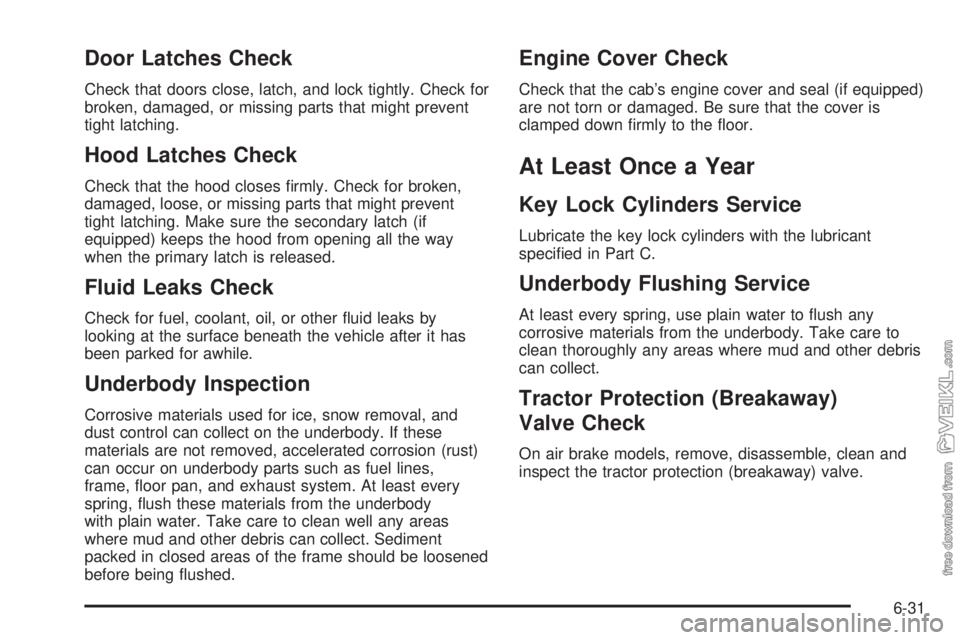
Door Latches Check
Check that doors close, latch, and lock tightly. Check for
broken, damaged, or missing parts that might prevent
tight latching.
Hood Latches Check
Check that the hood closes firmly. Check for broken,
damaged, loose, or missing parts that might prevent
tight latching. Make sure the secondary latch (if
equipped) keeps the hood from opening all the way
when the primary latch is released.
Fluid Leaks Check
Check for fuel, coolant, oil, or other fluid leaks by
looking at the surface beneath the vehicle after it has
been parked for awhile.
Underbody Inspection
Corrosive materials used for ice, snow removal, and
dust control can collect on the underbody. If these
materials are not removed, accelerated corrosion (rust)
can occur on underbody parts such as fuel lines,
frame, floor pan, and exhaust system. At least every
spring, flush these materials from the underbody
with plain water. Take care to clean well any areas
where mud and other debris can collect. Sediment
packed in closed areas of the frame should be loosened
before being flushed.
Engine Cover Check
Check that the cab’s engine cover and seal (if equipped)
are not torn or damaged. Be sure that the cover is
clamped down firmly to the floor.
At Least Once a Year
Key Lock Cylinders Service
Lubricate the key lock cylinders with the lubricant
specified in Part C.
Underbody Flushing Service
At least every spring, use plain water to flush any
corrosive materials from the underbody. Take care to
clean thoroughly any areas where mud and other debris
can collect.
Tractor Protection (Breakaway)
Valve Check
On air brake models, remove, disassemble, clean and
inspect the tractor protection (breakaway) valve.
6-31
Page 346 of 374
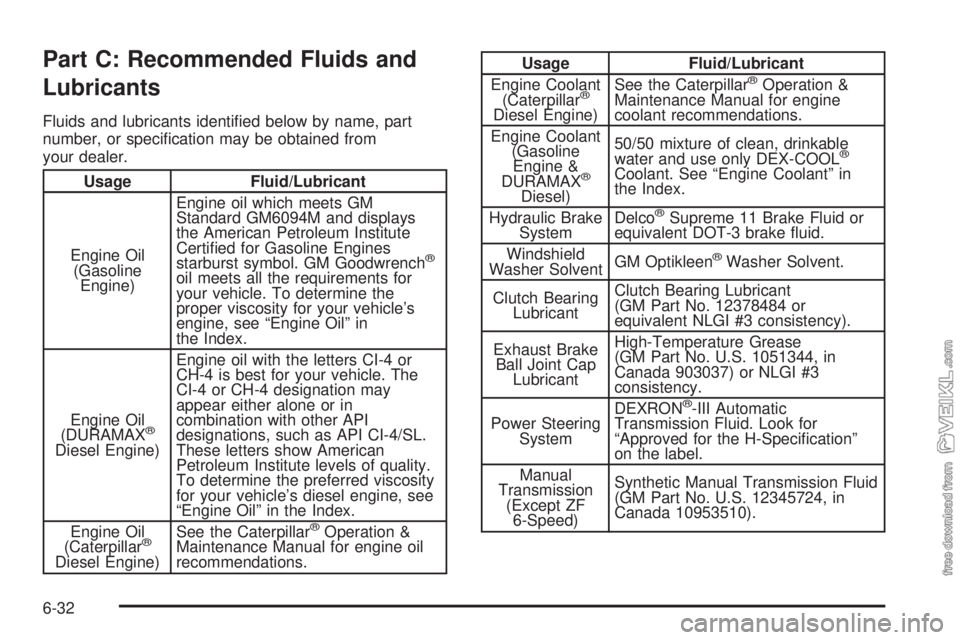
Part C: Recommended Fluids and
Lubricants
Fluids and lubricants identified below by name, part
number, or specification may be obtained from
your dealer.
Usage Fluid/Lubricant
Engine Oil
(Gasoline
Engine)Engine oil which meets GM
Standard GM6094M and displays
the American Petroleum Institute
Certified for Gasoline Engines
starburst symbol. GM Goodwrench
®
oil meets all the requirements for
your vehicle. To determine the
proper viscosity for your vehicle’s
engine, see “Engine Oil” in
the Index.
Engine Oil
(DURAMAX
®
Diesel Engine)Engine oil with the letters CI-4 or
CH-4 is best for your vehicle. The
CI-4 or CH-4 designation may
appear either alone or in
combination with other API
designations, such as API CI-4/SL.
These letters show American
Petroleum Institute levels of quality.
To determine the preferred viscosity
for your vehicle’s diesel engine, see
“Engine Oil” in the Index.
Engine Oil
(Caterpillar
®
Diesel Engine)See the Caterpillar
®Operation &
Maintenance Manual for engine oil
recommendations.
Usage Fluid/Lubricant
Engine Coolant
(Caterpillar
®
Diesel Engine)See the Caterpillar
®Operation &
Maintenance Manual for engine
coolant recommendations.
Engine Coolant
(Gasoline
Engine &
DURAMAX
®
Diesel)50/50 mixture of clean, drinkable
water and use only DEX-COOL
®
Coolant. See “Engine Coolant” in
the Index.
Hydraulic Brake
SystemDelco
®Supreme 11 Brake Fluid or
equivalent DOT-3 brake fluid.
Windshield
Washer SolventGM Optikleen
®Washer Solvent.
Clutch Bearing
LubricantClutch Bearing Lubricant
(GM Part No. 12378484 or
equivalent NLGI #3 consistency).
Exhaust Brake
Ball Joint Cap
LubricantHigh-Temperature Grease
(GM Part No. U.S. 1051344, in
Canada 903037) or NLGI #3
consistency.
Power Steering
SystemDEXRON
®-III Automatic
Transmission Fluid. Look for
“Approved for the H-Specification”
on the label.
Manual
Transmission
(Except ZF
6-Speed)Synthetic Manual Transmission Fluid
(GM Part No. U.S. 12345724, in
Canada 10953510).
6-32
Page 364 of 374
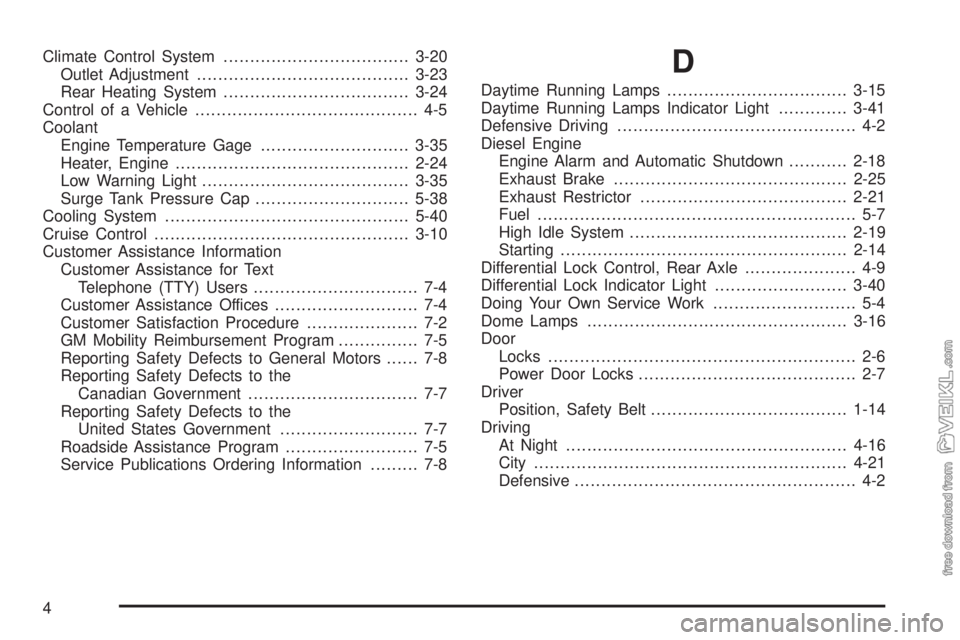
Climate Control System...................................3-20
Outlet Adjustment........................................3-23
Rear Heating System...................................3-24
Control of a Vehicle.......................................... 4-5
Coolant
Engine Temperature Gage............................3-35
Heater, Engine............................................2-24
Low Warning Light.......................................3-35
Surge Tank Pressure Cap.............................5-38
Cooling System..............................................5-40
Cruise Control................................................3-10
Customer Assistance Information
Customer Assistance for Text
Telephone (TTY) Users............................... 7-4
Customer Assistance Offices........................... 7-4
Customer Satisfaction Procedure..................... 7-2
GM Mobility Reimbursement Program............... 7-5
Reporting Safety Defects to General Motors...... 7-8
Reporting Safety Defects to the
Canadian Government................................ 7-7
Reporting Safety Defects to the
United States Government.......................... 7-7
Roadside Assistance Program......................... 7-5
Service Publications Ordering Information......... 7-8D
Daytime Running Lamps..................................3-15
Daytime Running Lamps Indicator Light.............3-41
Defensive Driving............................................. 4-2
Diesel Engine
Engine Alarm and Automatic Shutdown...........2-18
Exhaust Brake............................................2-25
Exhaust Restrictor.......................................2-21
Fuel............................................................ 5-7
High Idle System.........................................2-19
Starting......................................................2-14
Differential Lock Control, Rear Axle..................... 4-9
Differential Lock Indicator Light.........................3-40
Doing Your Own Service Work........................... 5-4
Dome Lamps.................................................3-16
Door
Locks.......................................................... 2-6
Power Door Locks......................................... 2-7
Driver
Position, Safety Belt.....................................1-14
Driving
At Night.....................................................4-16
City...........................................................4-21
Defensive..................................................... 4-2
4
Page 365 of 374
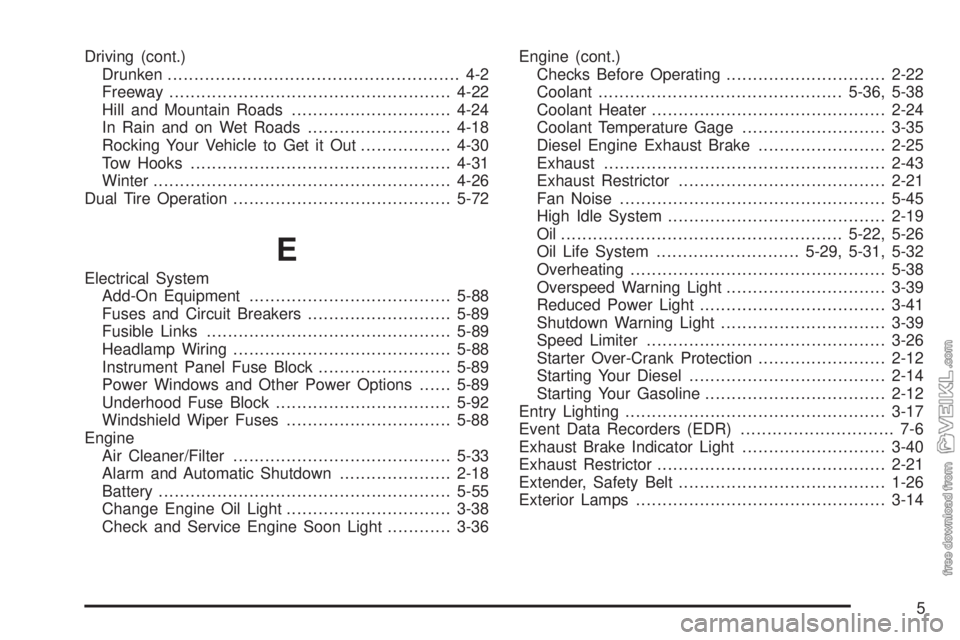
Driving (cont.)
Drunken....................................................... 4-2
Freeway.....................................................4-22
Hill and Mountain Roads..............................4-24
In Rain and on Wet Roads...........................4-18
Rocking Your Vehicle to Get it Out.................4-30
Tow Hooks.................................................4-31
Winter........................................................4-26
Dual Tire Operation.........................................5-72
E
Electrical System
Add-On Equipment......................................5-88
Fuses and Circuit Breakers...........................5-89
Fusible Links..............................................5-89
Headlamp Wiring.........................................5-88
Instrument Panel Fuse Block.........................5-89
Power Windows and Other Power Options......5-89
Underhood Fuse Block.................................5-92
Windshield Wiper Fuses...............................5-88
Engine
Air Cleaner/Filter.........................................5-33
Alarm and Automatic Shutdown.....................2-18
Battery.......................................................5-55
Change Engine Oil Light...............................3-38
Check and Service Engine Soon Light............3-36Engine (cont.)
Checks Before Operating..............................2-22
Coolant..............................................5-36, 5-38
Coolant Heater............................................2-24
Coolant Temperature Gage...........................3-35
Diesel Engine Exhaust Brake........................2-25
Exhaust.....................................................2-43
Exhaust Restrictor.......................................2-21
Fan Noise..................................................5-45
High Idle System.........................................2-19
Oil .....................................................5-22, 5-26
Oil Life System...........................5-29, 5-31, 5-32
Overheating................................................5-38
Overspeed Warning Light..............................3-39
Reduced Power Light...................................3-41
Shutdown Warning Light...............................3-39
Speed Limiter.............................................3-26
Starter Over-Crank Protection........................2-12
Starting Your Diesel.....................................2-14
Starting Your Gasoline..................................2-12
Entry Lighting.................................................3-17
Event Data Recorders (EDR)............................. 7-6
Exhaust Brake Indicator Light...........................3-40
Exhaust Restrictor...........................................2-21
Extender, Safety Belt.......................................1-26
Exterior Lamps...............................................3-14
5
Page 367 of 374
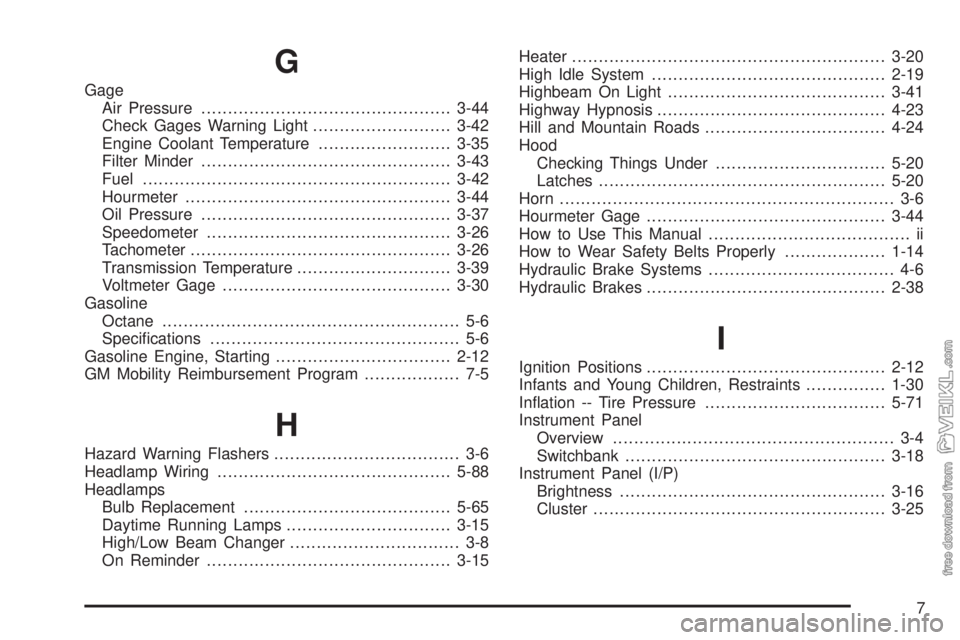
G
Gage
Air Pressure...............................................3-44
Check Gages Warning Light..........................3-42
Engine Coolant Temperature.........................3-35
Filter Minder...............................................3-43
Fuel..........................................................3-42
Hourmeter..................................................3-44
Oil Pressure...............................................3-37
Speedometer..............................................3-26
Tachometer.................................................3-26
Transmission Temperature.............................3-39
Voltmeter Gage...........................................3-30
Gasoline
Octane........................................................ 5-6
Specifications............................................... 5-6
Gasoline Engine, Starting.................................2-12
GM Mobility Reimbursement Program.................. 7-5
H
Hazard Warning Flashers................................... 3-6
Headlamp Wiring............................................5-88
Headlamps
Bulb Replacement.......................................5-65
Daytime Running Lamps...............................3-15
High/Low Beam Changer................................ 3-8
On Reminder..............................................3-15Heater...........................................................3-20
High Idle System............................................2-19
Highbeam On Light.........................................3-41
Highway Hypnosis...........................................4-23
Hill and Mountain Roads..................................4-24
Hood
Checking Things Under................................5-20
Latches......................................................5-20
Horn............................................................... 3-6
Hourmeter Gage.............................................3-44
How to Use This Manual...................................... ii
How to Wear Safety Belts Properly...................1-14
Hydraulic Brake Systems................................... 4-6
Hydraulic Brakes.............................................2-38
I
Ignition Positions.............................................2-12
Infants and Young Children, Restraints...............1-30
Inflation -- Tire Pressure..................................5-71
Instrument Panel
Overview..................................................... 3-4
Switchbank.................................................3-18
Instrument Panel (I/P)
Brightness..................................................3-16
Cluster.......................................................3-25
7